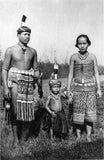Rare Tribal Ethnic Dayak Iban Tribe Talisman Necklace: Antique Hand Crafted Magical Lukut Sekala , Old Trade Glass Beads, Amber beads, Stone Bead, Chinese Coins, collected in 1980’s Borneo Aristocrat Owner, Indonesia. NB3
Older Borneo Ethnic Tribe Necklace
ITEM NB3
Collected 40+ years ago
(Seen on all the photos and also grouped with other necklaces collected at the same time, from Kalimantan)
The Primitive Tribal Orang Ulu, Iban and Dayak women wore with pride these original one of a kind necklaces:
This one dating from up to 80 years ago, unique, one of a kind, was made with a variety of older trade beads, Lukut sekala , amber beads, glass beads, pottery beads, central stone bead, and Chinese coins on each side of the center greyish stone piece.
Such body ornaments were also used as currency on the markets of Kalimantan. This sale is for the necklace with the grey round stone center piece, but the other necklaces you see here are also available in other sales.
Beads were always considered to have magical properties and were worn by the upper class.
In olden-day Borneo beads were an integral part of the indigenous people of Borneo, the Orang Ulu, for one. Designed and shaped from durable materials, like stone and glass, it was believed that each bead‘s reputed age indicated its power, and some believed that the owner of such beads could draw strength from it. The bearer, however, had to have the strength of soul to retain such a gift, otherwise it would only be a burden.
Among the aristocrats in Borneo, a commoner in possession of a special bead which they considered spiritual had to surrender it to the chieftain who, it was presumed, had a strong soul and reputation.
In Borneo beads were used as status symbols, for fines, currency, wealth and as investments.
Beads have been used since time immemorial, when also teeth, bones, shells and stones were perforated and worn as ornaments.
Good beads were not only valuable, they also revealed status. For example, beads were tokens of rank and value, and could attest to a future daughter-in-law’s eligibility to marry into the family.
The most expensive Lukut sekala and the ritually important Lukut bela daba were believed to be female or male, depending on whether the shape of the bead was long or flat. Only an aristocrat could own Lukut sekala.
So valuable were these beads that there is a legend of a trader who had crossed the Sarawak/Kalimantan border on foot, but wanted to travel down river from middle Baram. As legend would have it, he bought a second-hand outboard engine for one Lukut sekala bead. Another example of the beads’ value is that an expert Orang Ulu tattoo artist, usually female, could command a fee of up to five beads of the Lukut class per day, and even extra rice to take home. In the past, a fine Kelabit lady hat was worth one buffalo, so were 30 yellow peanut Let alai beads. A bead hat made of old, heavy beads, which are no longer fashionable and are becoming rare, can fetch one storehouse full of husked bario rice – if anyone was prepared to sell it.
But beads could also be used in beadwork as fine decorations. Orang Ulu baby carriers, a reed basket open on one side, used by women to carry their young infants, were embellished with such fine beadwork with a wild boar or leopard tooth finish. Large beads and hawk’s bells were attached to the upper rim of the carrier and served to soothe the toddler with their tinkling in addition to indicating status. The Orang Ulu believed that rank and its associated symbolism were serious considerations.
All our collector and rare items come with pages and pages of research about provenance, and with history of the tribes and photos as well, depending on item and whenever possible. When shipping internationally, we group ship multiple purchases to save you money, and find the best rates available. If you have any questions or want to see research conducted on this piece and photos of tribes, let us know.









































































































